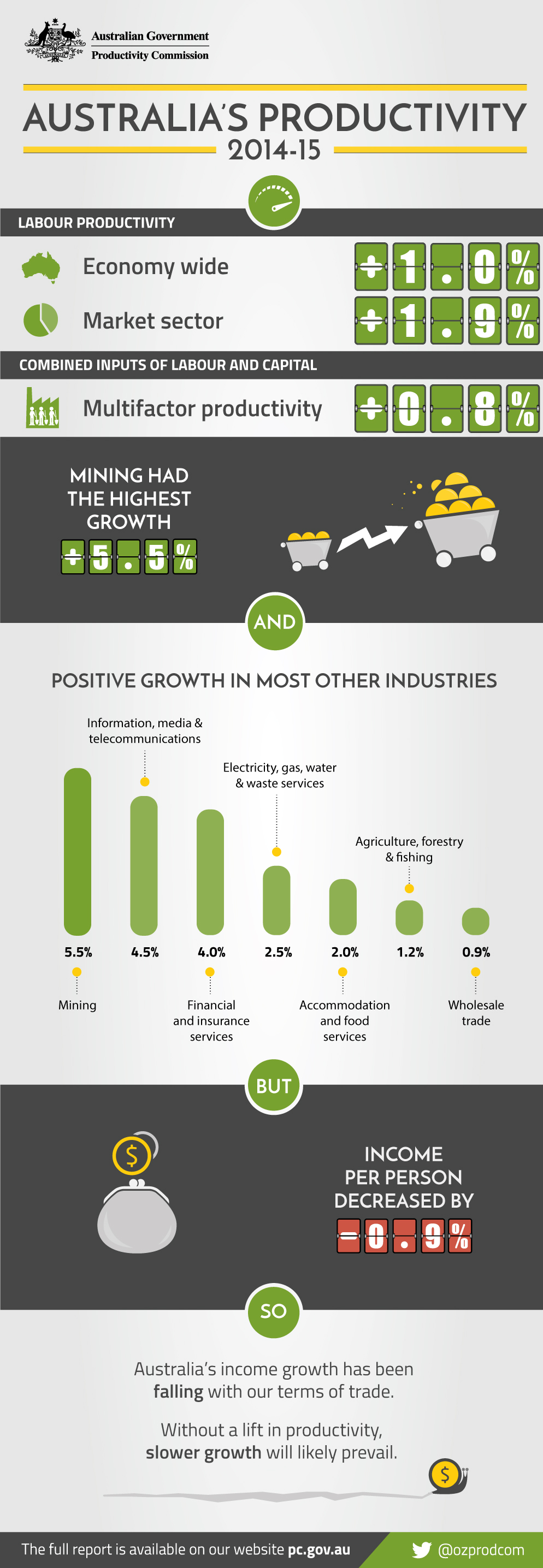PC productivity update 2016
ISSN 2202-7378
This publication was released on 26 April 2016 and in this edition the Commission analyses the latest ABS productivity statistics and comments on new developments underlying Australia's recent productivity performance.
Each edition will unpack the latest ABS productivity statistics, and report on the findings of the Commission's most recent research into productivity issues.
Download the update
- Productivity at a glance
- Infographic
- Addendum

Australia's labour productivity growth for the total economy (Text version of above image)
Annual change, 2013-14 to 2014-15, GDP per hour worked
Labour productivity +1.0%
Australia's productivity growth for the Market sector (12 industries)
Annual change, 2013-14 to 2014-15
Multifactor productivity +0.8%
Labour productivity +1.9%
Output +2.8%
Labour input +0.9%
Capital input +3.2%
Long-term, average annual growth rate, 1973-74 to 2014-15
Multifactor productivity +0.8%
Labour productivity +2.3%
Output +3.0%
Labour input +0.7%
Capital input +4.4%
Data sources: ABS (Australian System of National Accounts, 2014-15, Cat. no. 5204.0, December 2015); ABS (Estimates of Industry Multifactor Productivity, 2014-15, Cat. no. 5260.0.55.002, December 2015).
For more detailed productivity statistics and commentary see Chapter 1.

Download the infographic
Australia's Productivity 2014-15 (Text version of the infographic)
Labour productivity
- Economy wide +1.0%
- Market sector +1.9%
Combined inputs of labour and capital
- Multifactor Productivity +0.8%
- Mining had the highest growth +5.5%
- and Positive growth in most other industries
Mining +5.5% Information, media & telecommunications +4.5% Financial and insurance services +4.0% Electricity, gas, water & waste services +2.5% Accommodation and food services +2.0% Agriculture, forestry & fishing +1.2% Wholesale trade +0.9% - but Income per person decreased by -0.9%
- so Australia’s income growth has been falling with our terms of trade.
- Without a lift in productivity, slower growth will likely prevail.
More detail in the Update.
Table 1.1 on page 6 was updated on 19 May 2016 to the following:
| Long term growth rate 1973-74 to 2014-15 |
Last complete cycle 2003-04 to 2007-08 |
Period since the last cycle 2007-08 to 2014-15 |
Latest years | |||
|---|---|---|---|---|---|---|
| 2012-13 | 2013-14 | 2014-15 | ||||
| Output (GVA) | 3.0 | 4.0 | 2.5 | 2.5 | 2.5 | 2.8 |
| Total inputs | 2.2 | 4.0 | 2.4 | 2.2 | 2.0 | 2.0 |
| Labour input | 0.7 | 2.4 | 0.1 | -1.1 | -0.1 | 0.9 |
| Capital input | 4.4 | 6.0 | 4.9 | 5.8 | 4.2 | 3.2 |
| MFP | 0.8 | 0.0 | 0.0 | 0.3 | 0.6 | 0.8 |
| Capital deepeningc | 1.6 | 1.7 | 2.3 | 3.3 | 2.0 | 1.1 |
| Labour productivity | 2.3 | 1.6 | 2.3 | 3.6 | 2.6 | 1.9 |
| Capital labour ratio | 3.7 | 3.6 | 4.8 | 6.9 | 4.3 | 2.3 |
a Annual growth rates or average annual growth rates in designated periods. Cycles refer to productivity cycles b Includes Divisions A to K and R. Excludes Divisions L Rental, hiring and real estate services; M Professional, scientific and technical services; N Administration and support services; and S Other services. These four service sectors are excluded from the analysis due to issues around the measurement of capital services in these industries. Also the 12-industry market sector has a longer time-series. See Experimental Estimates of Industry Multifactor Productivity, 2009-10 (ABS Cat. No 5260.0.55.002).c Capital deepening is the change in the ratio of capital to labour, weighted by the capital share of market sector income. Labour productivity growth equals the sum of the growths of MFP and capital deepening.
Source: Productivity Commission estimates based on ABS (Estimates of Industry Multifactor Productivity, 2014-15, Cat. no. 5260.0.55.002, December 2015).